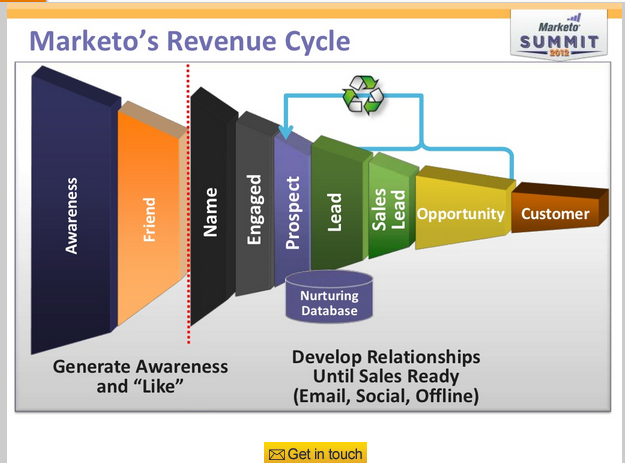I read a post by Jason Lemkin that really hit home (http://tinyurl.com/ktqeuys). And it hit home not because I have seen what he discusses happen way too many times, but because I am transitioning into a marketing leadership role. I got my marketing experience from not only growing a company from 2 people into a nice little company over a 10-year period of time, but that company just happened to be one of the very first marketing automation companies. I spent 10 years teaching Marketers Marketing Automation and how to use it for their business. It was an extremely valuable experience, and after having taken on leadership roles spanning Sales, Customer Success, Business Development & even Product - here I go !! So, thank you Jason for writing what I know to be true. You saved me a lot of typing.
Apologies to all those to whom this is already well known. But, I know many of you have never hired a head of marketing before. And as soon as you get your MSP (Minimum Sellable Product) out the door, and you’ve got your first 10 customers under your belt — you’re probably going to want to hire a VP or Head of Marketing to help you get more leads in, manage the process, and help get the word out.
All good stuff.
Let me just give you one tip. There are basically 2 types of SaaS and business web marketers. And if you hire the wrong type — the more common type — then instead of more customers, you may end up with just a bunch of Blue Pens with your logo on them.
Why’s that?
Well, for SaaS companies, marketing broadly speaking breaks into two species — Corporate Marketing and Demand Generation. Traditionally, with the larger software companies, and before the rise of the Internet as a true lead generation engine for B2B sales — Corporate Marketing Was King. And demand generation were the junior guys and gals in the backroom.
And because of this, you’re going to find the Web Leaders all spit out a ton of Corporate Marketers. At the end of the day, Corporate Marketing is all about protecting and reinforcing the brand once you are Way Past Scale. Corporate Marketing at Google, at Adobe, at Salesforce isn’t about getting the brand out there. Everyone that might buy has already heard of the brand, for the most part. Corporate Marketing is all about reinforcing positive images on the brand and product before a buying decision (to accelerate it and increase the odds of closing), and post-buying, so that you’ll buy more.
You’ll buy billboards and ultimately TV ads:

And maybe lots of blue logo pens.
Because once you have a brand, even just a mini-brand — this works. It’s just that brand marketing is very expensive in the early days — and frustratingly, generates zero leads. So it seems to have zero ROI. I can pretty much guarantee you the billboard above generated $0 in direct revenue for us. It’s worth it though, because EchoSign and the web services group are past $50m in ARR. Which means there’s a real brand to manage. Not an epic one yet, but a real one. And then you really do want to invest a lot in the brand. And as your revenues grow, it gets cheaper, because it’s a smaller and smaller % of your overall revenue. Eventually, you can buy billboards. And then eventually, maybe even TV if you want. And this stuff, later, becomes great. It reinforces your brand in the mind of the buyer, and when they are ready to buy … they’ll already know who you are, and hopefully, have some positive pre-conceptions.
Once you have a dominant brand, leads just follow here from the brand, because the brand creates so many leads and customers all on its own. For example, the Adobe Digital Media division does > $3 billion in revenue a year, and pretty much everyone knows about Photoshop, Acrobat, and the rest of the core products. The real art becomes getting people to buy more, and have the most positive relationship with the brand possible when they are considering buying.
>> So at this scale, “demand generation” really is seen as a second tier job, in some cases at least. The demand already is there, for the most part, and maintaining top-of-mindedness is a top priority.
Thus, the tech leaders are full of senior, smart Corporate Marketing folks. Protecting and reinforcing the brand, and doing a great job of it. Which is exactly the wrong hire for you. And these same tech leaders are often bereft of senior lead generation candidates for you to poach from.
Let’s contrast that to what SaaS start-ups care about: managing and creating leads. Let’s look at this nice chart from Marketo (a leader in SaaS marketing demand generation software) below … because that’s what you want to hire:

In particular, you want someone who is a pro at everything to the right of the dashed line. Someone that really understands how to do lead nurturing, web demand generation programs, and work at the hip of your sales team to generate a steady, growing stream of leads each and every month. And that’s not Corporate Marketing.
In the Fortune 500, sometimes Demand Gen folks are second-class citizens. But in the growing SaaS company, these folks are the Lords of Marketing. And the Great demand gen marketers can, until you’re ready, hack the stuff at the left. They may not be as into the squishy parts of marketing. Demand Gen folks are all about the numbers. Spend $Y, create Z leads, that should be worth 5 x $Y in revenue. So sometimes, their blue pens are not as pretty.
But Demand Gen folks can hack Corporate Marketing. Corporate Marketing cannot hack Demand Gen. Ever. It’s hopeless, in fact.
Here’s my only point. I know so many SaaS start-ups that go to hire a head of marketing. And they hire someone with a seemingly strong resume, from a strong tech leader. And they hire someone who is really Corporate Marketing.
That hire fails. And leaves you with nothing to remember him/her but some nice blue pens with your logo on them.
If you haven’t done it before, hold out for the unicorn. In SaaS, find someone who lives, breathes, loves, and understands Demand Generation marketing.